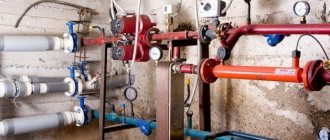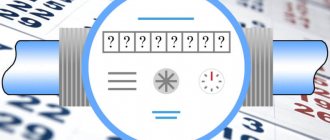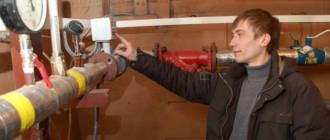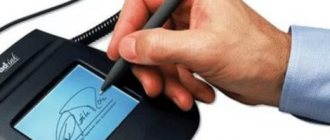What is ODPU on a receipt?
Let's figure out what the abbreviation ODPU means in housing and communal services receipts. Decoding the abbreviation - common house metering devices.
In apartment buildings, energy meters are installed, which are mounted in the basement. They belong to common property. Allows you to record the total consumption of electricity, heat energy, etc.
Common house metering devices record:
- thermal energy consumption;
- electricity consumption;
- hot and cold water consumption;
- use of domestic gas. Such devices are equipped in houses where water is heated with gas and supplied from a common boiler to apartments. Now there are almost no such houses left.
The devices record consumption throughout the apartment building. This includes expenses for general household needs. That is, the consumption of water, electricity, and heat for servicing common areas.
These include: entrances, staircases with stairwells, specialized rooms (if any), for example, strollers, etc. Thus, the energy resource consumption for servicing auxiliary common areas is taken into account.
Installing additional meters will allow you to reliably determine how many resources an apartment building consumes. Individual metering devices (IMU) do not provide a complete picture.
Only ODPU readings can provide a real picture of resource consumption. This takes into account unforeseen expenses, for example, leaking taps, leaks, etc.
The total readings of individual metering devices in all apartments of the building are subtracted from the monthly ODPU readings. The remaining figure is general house expenses. Their payment is divided among all homeowners.
Explanation of the abbreviation ODPU
ODPU are called common house metering devices; such equipment is located in apartment buildings and allows you to take into account the consumption of energy resources by residents of the entire apartment building (apartment building).
Each home owner has individual meters installed. But their presence is not enough to fully determine energy consumption. The most effective use of a combination of communal meters with individual ones, which allows, in addition to the resources consumed by residents, to determine the expense attributable to the maintenance of common property.
Types of ODPU
ODPU devices are mounted in a convenient place. Usually in the basement where the metering units are located.
They usually install there:
- Hot and cold water supply meters;
- Heat recording devices. Operates during the heating season;
- Gas meter, if the house is equipped with a local gas hot water heating device;
- Electricity meter.
The electricity meter is often located in a special room - an electrical room. It can be either in the basement or in another place. Types of ODPU are selected according to the resource consumption of an apartment building. The price of the devices also depends on this.
Water
ODPU HVS are common house cold water metering devices. In housing and communal services, difficulties arise in calculating water consumption in apartment buildings. Installing water meters will solve them.
Individual metering devices do not allow you to see the full picture of cold water consumption throughout the house. Installation of devices will help identify losses and unauthorized water withdrawal. As a rule, one cold water meter is not enough to control water supply.
At the same time, a hot water supply (DHW) metering device is installed. This is necessary to control overall water use. Since hot water is also spent on general needs, for example, when a cleaning lady washes the floor.
Heating
Several metering devices can be installed in the basement, performing different functions. So, in the heating unit of an apartment building, in addition to water meters, a device is installed that takes into account thermal energy.
It plays a major role when residents pay for heating. It should be taken into account that if the apartments have individual metering devices, the calculation is made according to the readings of the IPU and ODPU. Since all utility rooms for common use are heated. These include entrances, strollers, etc.
However, not all houses have the technical ability to install ODPU for heat. In this case, residents are forced to pay for heating according to current standards.
Gas
Modern apartment buildings are connected to centralized resource distribution systems. Even old houses that do not have a hot water supply were equipped with hot water heaters mounted directly in the apartment. Therefore, to account for it, the apartment-by-apartment IPU for gas is sufficient.
Now there are no more houses left where a single hot water heater was used for the entire entrance. Therefore, communal gas meters are not installed in apartment buildings.
If the house has an autonomous boiler room, the meter is mounted near the boiler. As a rule, a separate room with limited access is allocated for the boiler room.
Electricity
Electricity in the apartment building is used for public needs to illuminate stairwells, power elevators, and intercoms. And in some cases, to operate pumps that allow water to be supplied to the upper floors.
To account for the electrical energy spent on these needs, it is necessary to install a common house meter. Based on his readings and the IPU, electricity bills are calculated.
Installation of communal heat meters
The installation process of devices in apartment buildings is carried out in accordance with current legislation.
Who should install and pay?
Heat energy meters are an important tool that allows you to obtain real readings of the consumption of utility resources. For greater effect, in multi-storey buildings with many owners, it is customary to install a set of appropriate equipment - a thermal energy metering unit. The set of devices not only provides control over the amount of heat consumed, but also allows you to monitor the media’s compliance with the standard.
For apartment owners, the problem associated with paying for a common building meter and installing the device is quite important. According to the law, the following procedure applies:
- Based on Federal Law No. 261-FZ dated November 23, 2009, the installation of heat meters is carried out exclusively at the expense of the owners of residential and commercial premises of a multi-storey building. A similar norm is prescribed by RF PP No. 354, which states that all costs for providing the facility with meters are borne by the owners.
- Decree of the Government of the Russian Federation dated August 13, 2006 No. 491 (as amended for 2018) regulates that if the owners have not independently decided to place an ODPU in the house, a common meter will be installed forcibly. In such a situation, each owner must pay part of the assigned amount within the prescribed period. Exceptions apply if funds were provided for installation, which were formed as targeted contributions or other types of savings.
- Based on execution of No. 261-FZ, residents can take advantage of the opportunity to install heat meters on the heating system, which involves receiving installments for up to 5 years. In such a situation, the meter and installation will ultimately cost more, because an additional annual interest is added, which is calculated based on the refinancing rate of the Central Bank of the Russian Federation.
The installation of flow meters is carried out only by specialized organizations: commercial structures with the appropriate approval or heat supply companies, which most often provide a full range of paid and free services (placement, adjustment, testing, commissioning and sealing). When contacting private companies, the utility service provider must be informed about the work being carried out and issue the appropriate permit.
On a note! The installed meter is put into operation by the resource supplier, and only organizations or persons with appropriate qualifications are allowed to perform servicing.
Is it possible to refuse
Apartment owners cannot independently decide that a house connected to a centralized heating system will not be equipped with a common meter. But there are reasons why heat meters cannot be installed even forcibly for heating:
- Work cannot be performed without changing the structure of the facility or systems located inside.
- The house is recognized as dilapidated or in disrepair and is subject to resettlement.
- It is impossible to ensure compliance with the standards that apply to the installation site and external factors: to organize free access to the installation site of the meter, to exclude exposure to humidity, temperature or electromagnetic interference.
House-wide heat energy metering systems must be located in specially equipped and, most importantly, dry rooms, otherwise the installation of meters is prohibited
The main factors are recorded in Order No. 627 dated December 29, 2011, which was approved by the Ministry of Regional Development of the Russian Federation. The management company or homeowners association, together with the heat supply organization, must draw up and confirm the impossibility of placing the device with a corresponding act.
Legal requirements
The government has determined at the legislative level that the operation of apartment buildings without communal metering devices is prohibited.
The procedure for calculation and payment is defined in Resolution No. 354 of May 2, 2011.
There was a transition period until 2021. It is necessary for the management company and housing department to conduct an audit of the housing stock and bring it into compliance with the law.
Now the installation of ODPU in apartment buildings is mandatory. In the absence of metering devices, payment for general house needs from 2021 is made using an increasing coefficient. At the same time, on April 16, 2013, Resolution No. 344 clarified the calculation procedure.
- General household expenses cannot exceed established standards;
- The current standards for cold and hot water have been reduced;
- Payments for sewerage and heating of common property were canceled;
- An increasing coefficient has been established for houses in which ODPU are not installed. Provided that installation is technically possible.
In this case, the fee for installing the ODPU is borne by the residents of the house. The resolution provides for leasing for 5 years.
Installation and maintenance features
In order to establish ODPU, the consent of all residents of the apartment building is not required. The resource supplying organization has the right to force installation of devices. Representatives of the management company are obliged to notify the owners of the need to install ODPU.
The acquisition, installation, assembly, and commissioning of equipment is carried out by the Management Company together with a specialized organization. The choice of organization and equipment is made by the residents of the house.
Representatives of the management company have only an advisory vote. In this case, the representative is obliged to explain to the owners that the costs of installing the ODPU are borne by the residents.
In addition, owners are obliged to:
- After the general meeting and selection of a contractor, enter into an agreement for the purchase, installation and commissioning of equipment. Payment for installation of ODPU, commissioning, etc. lies with the residents of the house;
- Maintenance of metering devices can be performed by the housing department or a contractor. This is decided by the owners;
- The service contract stipulates that the operation is carried out by a contracting organization that has the right to do so;
- She must also ensure that the equipment is in good working order. Repair the ODPU and, if necessary, replace it. It is possible that these responsibilities can be assigned to the housing department, subject to the appropriate license.
How are counting devices checked and maintained?
The operation of any meters involves the need for maintenance and monitoring of technical condition. If the technical condition of the device does not allow its use, the device should be replaced. This condition also applies to public meters.
The costs for performing the specified work are distributed among the residents of the apartment building, and organizational actions are distributed to the management company. Installation, maintenance and replacement of ODPU requires the contractor to have permits. The management company selects an organization that has the appropriate licenses and draws up contracts to perform the specified work.
Completed work is documented with appropriate acts that record the volumes closed to the contractor. During the inspection, the report notes any identified defects that require elimination. The act is signed by an authorized representative of the executing organization and, on the other hand, by an official of the management company.
The need to install communal metering devices is beyond doubt. Residents must take a responsible approach to making a decision on the need to use the DPPU, which will allow them to record the amount of resources spent on maintaining common property and minimize the cost of paying for them.
Who pays for installation and how?
The costs associated with these works are paid by the owners. Since the equipment is expensive, the decree provides for installment payment or leasing, which is designed for 5 years.
All costs associated with the installation of equipment, its subsequent operation, repair, and replacement are proportionally distributed among the residents of the apartment building.
There are three payment options:
- Residents pay for installation immediately.
- Payment in installments over 5 years. This amount (plus bank interest for installments) will appear on the housing and communal services receipt. The item is called “installation of ODPU”.
- Use target savings of the utility service provider allocated for energy saving and energy efficiency measures. This is the difference between the standard and the amount taking into account the increasing factor (for apartments where individual meters are not installed). Housing and communal services accountants are required to keep this money separate from general receipts. These funds can be used to install meters.









